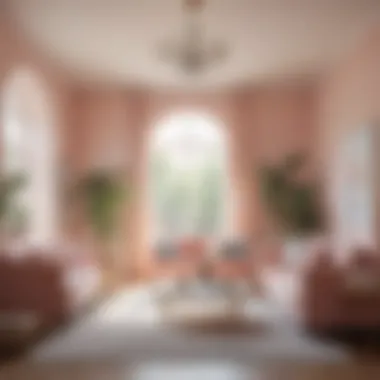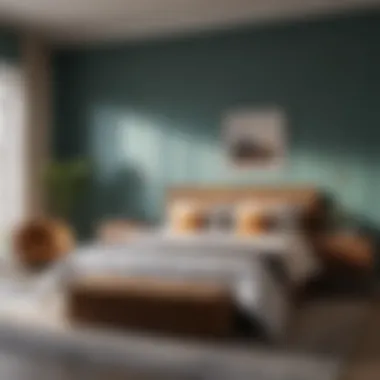Discovering the Perfect Colours to Transform Your Home


Intro
Choosing the right colours for your home can significantly influence its overall aesthetic and functionality. The psychology of colour plays an essential role in how we perceive and interact with our living spaces. Each hue carries implications; warm tones evoke energy and comfort, while cooler shades may inspire calm and tranquility. Understanding these nuances helps discerning homeowners make more informed decisions.
This article aims to ground your choices in evidence-based insights and trends in home design. By considering your personal style alongside these elements, you can effectively enhance your home's ambience and appeal. In this exploration, we will examine various factors, from current colour trends to how these can be harmonized within your space, ensuring your selections reflect both your lifestyle aspirations and the inherent character of your home.
Outdoor Decor Ideas
Outdoor spaces often serve as extensions of your home’s interior, making their colour choices equally significant. Selecting the right colours can transform patios, gardens, and entryways, creating inviting atmospheres for relaxation and entertainment. Here are several critical aspects to consider:
Seasonal Inspirations
Leveraging seasonal colours can keep your outdoor decor fresh and engaging throughout the year. In spring, opt for pastel hues like soft pink or mint green to reflect the vibrancy of blooming flowers. Summer offers bolder options, such as bright yellows and vivid blues. In autumn, earthy shades such as terracotta or olive green can complement the changing foliage. Winter calls for deeper tones, like navy or burgundy, to create a warm, cozy feel against the cold.
Furniture Selection
When choosing colours for outdoor furniture, durability is paramount. Look for weather-resistant materials that come in a spectrum of colours. Neutral tones may provide versatility, making it easier to switch up your decor with accessories. Bright colours like cobalt blue or citrus shades can add a pop of excitement to otherwise subdued palettes.
Decorative Lighting
Lighting can dramatically alter the feel of your outdoor space. Well-placed coloured lights can create ambience, enhancing the overall appeal. Consider warm white lights for an intimate atmosphere or vibrant lanterns for festive occasions. The right colour temperature can influence how colours are perceived, thus affecting your outdoor’s aesthetic depth.
Plant Arrangements
The colours found in your garden serve as a backdrop and focal point for your outdoor decor. Selecting plants with diverse leaf colours and flowering traits can add texture and interest. Consider seasonal plants that align with your home’s colour scheme for a cohesive appearance.
Hardscaping Solutions
Hardscape elements, like patios and walkways, provide structure to your outdoor areas. Choose stones or pavers in colours that complement your home’s exterior. You might explore options like grey or beige stones for a timeless effect or vibrant red bricks for a more contemporary feel.
Sustainable Practices
Sustainability is an ever-growing trend in home design. When planning outdoor colour schemes, consider using eco-friendly paint and materials. These often boast lower environmental impacts and can come in various colours without compromising on style.
A well-thought-out colour scheme can not only elevate your home's aesthetic appeal but also create spaces that resonate with personal identity and lifestyle choices.
Understanding Colour Psychology
Understanding colour psychology is crucial when selecting paint for your house. Colours play a significant role in forming the ambience and emotional tone of a space. They can affect moods, perceptions, and even interactions among individuals within that space. Therefore, choices go beyond mere aesthetics; they implicate deeper psychological effects.
The right colour scheme can create harmonious living environments. It impacts not just how a room looks but also how it feels to those who inhabit it. For discerning homeowners, understanding the implications of different colours can be beneficial in selecting hues that enhance well-being and comfort.
The Influence of Colour on Mood
Different colours evoke various emotional responses. Blue is often associated with tranquility. It may bring about a sense of relaxation. Yellow, on the other hand, can stimulate feelings of happiness and energy. However, too much can overwhelm, leading to agitation instead of cheer.
Red tends to provoke passion but can also induce feelings of aggression if overused. Green offers balance and rejuvenation, reminiscent of nature. Demonstrating an acute understanding of these influences can lead to well-considered design choices.
“Colour has the power to influence perceptions and emotions.”
Cultural Significance of Colours
Colours also hold different meanings across cultures. In Western cultures, white is typically associated with purity and innocence. In some Eastern cultures, it is linked with mourning. Red is celebrated in many Asian cultures for its association with good fortune and happiness. Knowing these significances allows homeowners to be culturally sensitive in their choices. It reminds that paint colour is not merely a surface change but an expression of personal identity and values.


This cultural aspect should be integrated into the selection process. It deepens the relevance of a colour within the context of a family’s heritage or community ties.
In summary, understanding colour psychology is not just an academic exercise; it is practical guidance for creating effective and appealing living environments. By taking into account the influence of colours on mood and their cultural meanings, homeowners can make informed decisions that influence both aesthetics and emotional well-being.
Choosing Your Colour Palette
Selecting the right colour palette is a pivotal aspect of creating an inviting and aesthetically pleasing home environment. The colour palette not only defines the aesthetic appeal but also plays a critical role in shaping the atmosphere within your space. It reflects personal taste and can significantly impact how one feels in their surroundings. By carefully considering the colours you choose, you can harmonize your living area, increasing relaxation, comfort, and even productivity.
When embarking on this journey, it is essential to evaluate several factors. First, consider the functionality of each room. Different rooms serve unique purposes— for example, a bedroom may benefit from calming hues, while a kitchen might thrive on more vibrant and energetic shades. Second, light conditions must also be taken into account, as natural and artificial lighting can greatly alter the perception of colour. Thus, testing how colours appear at various times of the day gives a clear insight into how different palettes will work in your home.
Moreover, achieving a cohesive look throughout various spaces can enhance the flow of your home. Color harmonization can create visual interest while maintaining a sense of unity. Therefore, delving into colour theory, such as understanding the relationships between colours, will aid in making informed decisions.
Consideration of Architectural Style
Understanding architectural style is crucial when it comes to selecting the perfect colors for your home. The design of a house is not just a matter of personal preference; it also influences and harmonizes with the surrounding environment. Each architectural style has its own character, and selecting colors that complement this character helps create a cohesive and appealing aesthetic. This consideration enhances the overall appearance of the house, boosts its curb appeal, and may even increase property value.
When evaluating your architectural style, take into account the elements such as shape, size, materials, and the overall concept of your house. It's important to recognize that colors can either accentuate or detract from these structural details. A well-thought-out color choice not only showcases the unique attributes of your home but also aligns with neighborhood norms and architectural guidelines.
Modern Designs and Bold Colours
Modern architecture often embraces clean lines and minimalism, favoring forms that exude a sense of sophistication. Here, bold colors can make a striking statement. Shades like deep navy or vibrant emerald green can pair with stark whites or cool grays, creating a stunning contrast that defines a modern structure. Outlining details with bright hues can amplify the architectural elements and provide a dynamic look.
A bold color can bring life to a modern home, inspiring energy and creativity. Yet, it’s essential to remain cautious. A color that is too overpowering could overshadow the beauty of the design.
Key considerations for using bold colors:
- Balancing Act: Ensure bold colors are balanced with neutral tones.
- Contextual Awareness: Consider how colors interact with the environment.
- Timeless Quality: Opt for colors that remain desirable over time.
Traditional Architecture and Earthy Tones
In contrast, traditional architecture often favors earthy tones that blend seamlessly with nature. This may include shades of beige, terracotta, or moss green. These colors evoke a sense of warmth and stability, resonating with the historical significance and charm of classic design.
When painting a traditional home, the right color palette can enhance ornamental details, from moldings to windows. The aim should be to respect the historical integrity of the property while still providing a fresh perspective on age-old aesthetics.
Benefits of using earthy tones include:
- Natural Cohesion: Compliments outdoor landscaping and natural elements.
- Visual Calmness: Instills a sense of tranquillity and comfort.
- Versatile Application: Suitable for both the exterior and interior spaces.
Ultimately, considering your architectural style guides you in making informed decisions about colors, enriching both the home and its surroundings. Such thoughtful integration can transform not just your living space but also elevate the entire neighborhood aesthetic.
Popular Colour Choices for Modern Homes
In contemporary residential design, the selection of colours holds significant power over the aesthetic and emotional experience of a space. Understanding popular colour choices allows homeowners to create environments that are not only visually appealing but also reflective of their personality and lifestyle. Choosing the right hues can enhance the perceived space, invoke desired feelings, and respond to the surrounding elements in the home.
This section explores three categories of popular colours that are particularly well-suited for modern homes: neutral colours, pastel shades, and vibrant colours. Each category presents distinct qualities that contribute to creating a harmonious living space.
Neutral Colours: A Timeless Selection
Neutral colours are foundational to modern home design. They serve as a blank canvas, offering versatility and adaptability to various styles of decor. Shades such as beige, gray, and white are especially popular. These tones provide a calm backdrop and allow other design elements, like furniture and artwork, to stand out.
Benefits of Neutral Colours:
- Flexibility: Neutral tones easily pair with almost any other colour, making it simple to change decor without a complete repaint.
- Timelessness: They do not easily go out of style, offering longevity to the design.
- Brightness: Lighter neutral shades enhance natural light, promoting a spacious feel.


However, it's essential to consider the undertones in neutral colours, as they can vastly change the mood of a room. For instance, warm neutrals create a cozy atmosphere, while cool neutrals lend a more serene and peaceful vibe.
Pastel Shades: Soft and Inviting
Pastel shades are ideal for creating inviting and serene spaces. These colours, like soft pinks, light blues, and gentle greens, exude a calming effect and can make a space feel more warm and welcoming. They are especially effective in spaces designated for relaxation, such as bedrooms and living rooms.
Considerations with Pastels:
- Subtlety: The gentle nature of pastels means they work best when they are balanced with more neutral or bold accents.
- Layering: Using different pastel hues can add depth and dimension without overwhelming the senses.
- Seasonal Shift: These colours can adapt well to different seasons, reflecting a breezy summer or a soft winter aesthetic.
Incorporating pastel shades into the overall colour scheme can create a fresh look, appealing to those who desire a sense of tranquillity in their home.
Vibrant Colours: Making a Statement
Vibrant colours are perfect for those wishing to express their creativity and individuality boldly. Shades like deep teal, bright yellow, or rich magenta can energize a space and serve as a focal point. These colours can be used as accents in furniture, or feature walls to bring life to modern interiors.
Benefits of Vibrant Colours:
- Energy: They can infuse a room with vitality and enthusiasm, making spaces feel more alive.
- Focal Points: Using bold colours strategically can draw attention to specific areas or architectural features in a home.
- Personal Expression: Vibrant colours allow homeowners to showcase their unique personality and style in a way that neutrals cannot.
For best results, it is advisable to use vibrant colours sparingly, balancing them with complementary or neutral tones to avoid visual overwhelm.
Exploring colour choices transitions the ordinary to the extraordinary. Selecting shades that reflect both style and emotional resonance transforms the very essence of a home.
The Role of Natural Light
Natural light plays a pivotal role in how colours appear in a home. It can greatly influence the mood and ambience of a space. Understanding how natural light interacts with colours is essential for making educated decisions when choosing paint. Homeowners should consider factors such as light direction, intensity, and the time of day when assessing potential colour schemes. The interplay of these elements can either enhance or diminish the tones you select, often transforming a room's overall feel.
Understanding Light Exposure
The orientation of a home affects how much natural light each room receives. For example, a room that faces south will likely experience more direct sunlight throughout the day, while a north-facing room might appear cooler and darker. Knowing these characteristics allows for more insightful colour choices. Warm colours can brighten dark spaces, while cooler tones can balance out overly bright areas.
- North-facing rooms: These spaces receive softer, diffused light, which can create a calm atmosphere. Warmer shades, like soft yellows or cream, may be suitable here to bring warmth and brightness.
- South-facing rooms: These areas enjoy abundant sunlight. Cool colours like blues or greens can help temper the heat during peak sunlight hours.
- East and West-facing rooms: These rooms get morning and afternoon light, respectively. The morning light tends to be cooler and more subtle. Conversely, the evening light is warmer and richer, making it essential to assess how your chosen colour will change throughout the day.
Impact of Light Reflection on Colour Perception
Light reflection ultimately alters how colours are perceived in your space. Every surface in a room, from walls to furniture, impacts the overall colour dynamics. Reflective surfaces can act as amplifiers for colour hues, while matte finishes absorb light, often making colours appear muted.
Understanding how light reflects can be crucial for determining the best colours to paint your home. Consider how your chosen finish will interact with natural light.
When selecting paint finishes, keep these factors in mind:
- Glossy finishes tend to reflect light, which can enhance brighter colours and make a room feel lighter and airier.
- Matte finishes provide a more subdued appearance, where colours might seem deeper and more grounded, especially in areas with strong sunlight.
In summary, evaluating natural light exposure and reflection is vital for informed colour selection. Engaging with these concepts sufficiently allows homeowners to create beautiful, harmonious spaces that adapt well throughout the day.
Testing Your Colour Choices
Testing your colour choices is an essential step in the journey of painting your house. It goes beyond mere selection; it involves applying thought and precision. The success of a paint job depends on how well colours fit within the desired ambiance and function of each space. Moreover, it helps to avoid costly mistakes that arise from hasty decisions.
One notable advantage of testing is the ability to observe how colours interact with existing elements in your home. Lighting, furniture, and even the size of the room can significantly alter a colour’s appearance. Performing trials allows you to make adjustments early in the process, ensuring the final result meets your expectations.
Using Paint Samples Effectively


When it comes to using paint samples, the approach can determine the outcome. Firstly, invest in high-quality paint samples from reputable brands such as Sherwin-Williams or Benjamin Moore. These companies provide rich, pigment-rich formulas that showcase colours authentically.
It's advisable to apply samples on larger sections of the wall or board rather than small swatches. This method gives a more accurate reference point. Furthermore, maintain consistent lighting conditions when observing the samples. Typical sources of light, like natural sunlight and indoor bulbs can alter how the colours appear. Hence, compare the samples at different times of the day.
Make a list of your preferred samples, rating them based on the mood they evoke, their compatibility with furniture, and natural light exposure. This structured evaluation will assist in narrowing down the selection effectively.
Visualizing with Colour Swatches
Visualizing your colour options with swatches is another powerful technique. Swatches offer a tangible reference, helping to create a cohesive vision for your space. This process allows for a complementary assessment alongside fabric, cabinetry, and flooring materials.
Collect swatches from various paint stores or online sources like Behr or Valspar. Ensure the swatches represent the full depth of colour to gauge how they will work in your home. Arrange swatches in clusters, grouping similar shades together to spot potential conflicts or harmonies among colours. Some points to keep in mind during this phase include:
- Keep swatches near the furniture they will be paired with.
- Observe how they blend with the room’s existing decor.
- Be mindful of contrasting and complementary aspects.
In summary, engaging in these testing processes can substantially influence your satisfaction with the outcome. By investing time and effort into assessing paint samples and visualizing swatches, you foster well-informed decisions that enhance your home's aesthetics.
Trends in Colour for Interiors and Exteriors
In the dynamic world of interior and exterior design, staying attuned to prevailing colour trends is essential. This section examines these trends, elucidating their impact on the aesthetic and market value of homes. Understanding these trends aids homeowners and designers in making informed decisions that align with both contemporary tastes and timeless principles.
Emerging Colour Trends in Home Design
Current trends reflect a movement towards colours that evoke feelings and create atmosphere. There is a significant shift towards soft, muted tones paired with bolder accents. Trending colours include warm neutrals like soft taupe and sandy beige, which provide a soothing backdrop, complemented by striking accents in colours like deep navy or forest green.
Another noticeable trend is the increasing popularity of black. Using black as an accent colour—especially in kitchens and bathrooms—adds sophistication and an element of modernity. Meanwhile, earthy shades inspired by nature, such as terracotta and mossy green, also find their place as homeowners seek to bring the outdoors in.
This shift towards natural shades connects with the rising interest in wellness and sustainability. Using paint colours that mimic nature can create calming environments, which are particularly desirable in high-end living spaces. Choosing colours that reflect natural elements not only enhances the aesthetic but may also increase a home's commercial viability.
Sustainable and Eco-Friendly Options
As the awareness of environmental issues grows, the choice of sustainable colour options takes on greater significance. Paint manufacturers are increasingly offering eco-friendly paints, which have lower levels of volatile organic compounds (VOCs). These paints contribute less to air pollution and provide healthier living spaces.
Homeowners can explore options that utilize natural pigments, which can range from clay-based paints to those made from plant-based materials. By selecting sustainable choices, homeowners can achieve a stylish look while consciously contributing to a healthier environment.
- Low-VOC Paints: These are less harmful to indoor air quality and can be a great choice for homes with children or allergy sufferers.
- Natural Paints: Typically made from renewable materials, they are biodegradable and come in a smaller range of colours.
- Energy-efficient Colouring: Opting for shades that reflect sunlight can reduce indoor temperature, providing an eco-friendly cooling effect.
The trend towards sustainability in home colour choices speaks to a larger global movement towards eco-awareness. This conscious decision often aligns with affluent buyers’ desire for luxury products that are both beautiful and responsible. As such, selecting energy-efficient and sustainable colours is not only a reflection of personal style but also of one’s commitment to environmental well-being.
In a world where environmental impact is in the spotlight, the choice of colour transcends aesthetics; it becomes a statement of values and lifestyle.
Closure
Painting your house is not just a task; it is an expression of individuality and taste. The conclusion of this exploration underscores the myriad of factors that influence the choice of colours. Understanding these factors, such as the psychological impact of colours, the architectural context, and the trends within home design, is crucial for making informed decisions. It goes beyond aesthetics and touches on emotional resonance and the way spaces are experienced.
Selecting suitable colours can elevate the ambiance of a room. This can lead to not only enhanced visual appeal but also a greater sense of well-being for those who live within the space. The permanence of a paint choice necessitates careful consideration. It cannot be understated that the collision of style, mood, and practicality requires a thoughtful approach.
A carefully curated palette can unify disjointed spaces, infusing character and a sense of coherence throughout a home. There is an elegance in balance that can be achieved when one understands how colours interact with light and shadow. The evolution of colour trends also invites homeowners to regularly revisit their choices, aligning with contemporary design vocabularies.
Final Thoughts on Colour Selection
When deciding on colour, think deeply about the statement you wish to make. What mood do you wish to evoke in each room? For example, calm blues might be ideal for bedrooms, while energizing yellows can uplift a kitchen or creative space.
- Some final thoughts to consider in your journey:
- Personal Style: Reflect on your own preferences before conforming to trends.
- Harmonious Choices: Aim for a palette that flows well from one room to another.
- Test Samples: Always test a few samples on walls to see how they react with natural light.
In closing, the art of colour selection is a blend of intuition and knowledge. Engage fully in the process. Find colours that resonate with your lifestyle values.
"Colour is a power which directly influences the soul." – Wassily Kandinsky
Your home is your canvas. Take the time to select your colours wisely, for they play an indelible role in shaping not only the appearance but also the experience of your living spaces.







